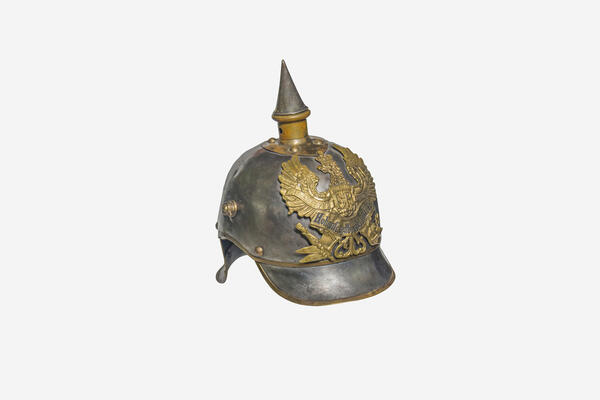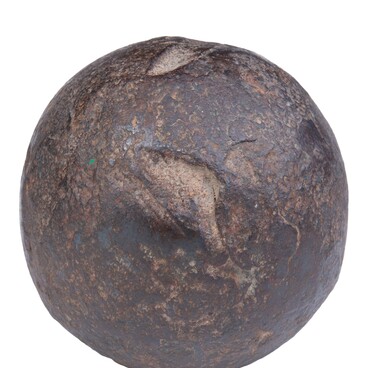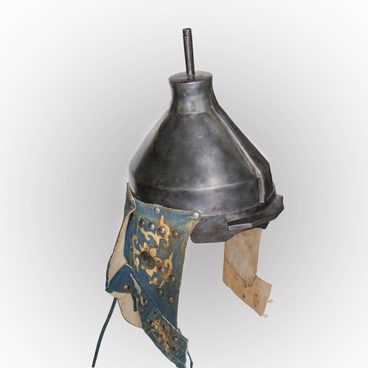‘Pickelhelm’ means ‘pointed helmet’ in German. Such helmets were introduced in the Prussian army in 1842 by the order of King Frederick William IV. Armies of other German states soon began to use pickelhelms.
The helmet base was made of reinforced boiled leather. It was treated to a glossy black sheen, and reinforced with metal trim, usually plated with gold or silver. A metal spike was fixed on the crown.
Full metal helmets were mostly worn by the cuirassiers 一 a type of heavy cavalry. One can see them in many grand portraits of the high-ranking German military and political figures.
All helmets produced for infantry in 1914 were made of leather. However, during World War I, supplies of leather in Germany began to run low. In 1915, several pickelhelms were made of steel sheets as an experiment.
A steel pickelhelm of the Prussian officer was a semi-sphere produced from white metal. The helmet front was decorated with a plate in the form of the large winged eagle — the emblem of Prussia, with the monogram of King Frederick ‘FR’ and the motto ‘With God for king and country! ’
However, the import of steel from South America soon ended. The helmets for the Prussian army were now produced from other materials: artificial leather, thick paper, pressed potato peelings, and even overripe pumpkin skin.
When World War I turned from the war of maneuver into the war of position, it became clear that pickelhelm was not appropriate for trench warfare. The crest often stuck out from the cover showing where a soldier is. Sometimes the enemies tried to shoot the spike off to scare the Germans. In 1915, a pickelhelm with removable spike appeared, but it didn’t last long.
Since 1916, pickelhelm was replaced with a new German steel helmet 一 stahlhelm. Later only high-ranking officials wore pickelhelms during official ceremonies. With the collapse of the German Empire in 1918, the pickelhelm ceased to be part of the military uniform.
The helmet base was made of reinforced boiled leather. It was treated to a glossy black sheen, and reinforced with metal trim, usually plated with gold or silver. A metal spike was fixed on the crown.
Full metal helmets were mostly worn by the cuirassiers 一 a type of heavy cavalry. One can see them in many grand portraits of the high-ranking German military and political figures.
All helmets produced for infantry in 1914 were made of leather. However, during World War I, supplies of leather in Germany began to run low. In 1915, several pickelhelms were made of steel sheets as an experiment.
A steel pickelhelm of the Prussian officer was a semi-sphere produced from white metal. The helmet front was decorated with a plate in the form of the large winged eagle — the emblem of Prussia, with the monogram of King Frederick ‘FR’ and the motto ‘With God for king and country! ’
However, the import of steel from South America soon ended. The helmets for the Prussian army were now produced from other materials: artificial leather, thick paper, pressed potato peelings, and even overripe pumpkin skin.
When World War I turned from the war of maneuver into the war of position, it became clear that pickelhelm was not appropriate for trench warfare. The crest often stuck out from the cover showing where a soldier is. Sometimes the enemies tried to shoot the spike off to scare the Germans. In 1915, a pickelhelm with removable spike appeared, but it didn’t last long.
Since 1916, pickelhelm was replaced with a new German steel helmet 一 stahlhelm. Later only high-ranking officials wore pickelhelms during official ceremonies. With the collapse of the German Empire in 1918, the pickelhelm ceased to be part of the military uniform.



